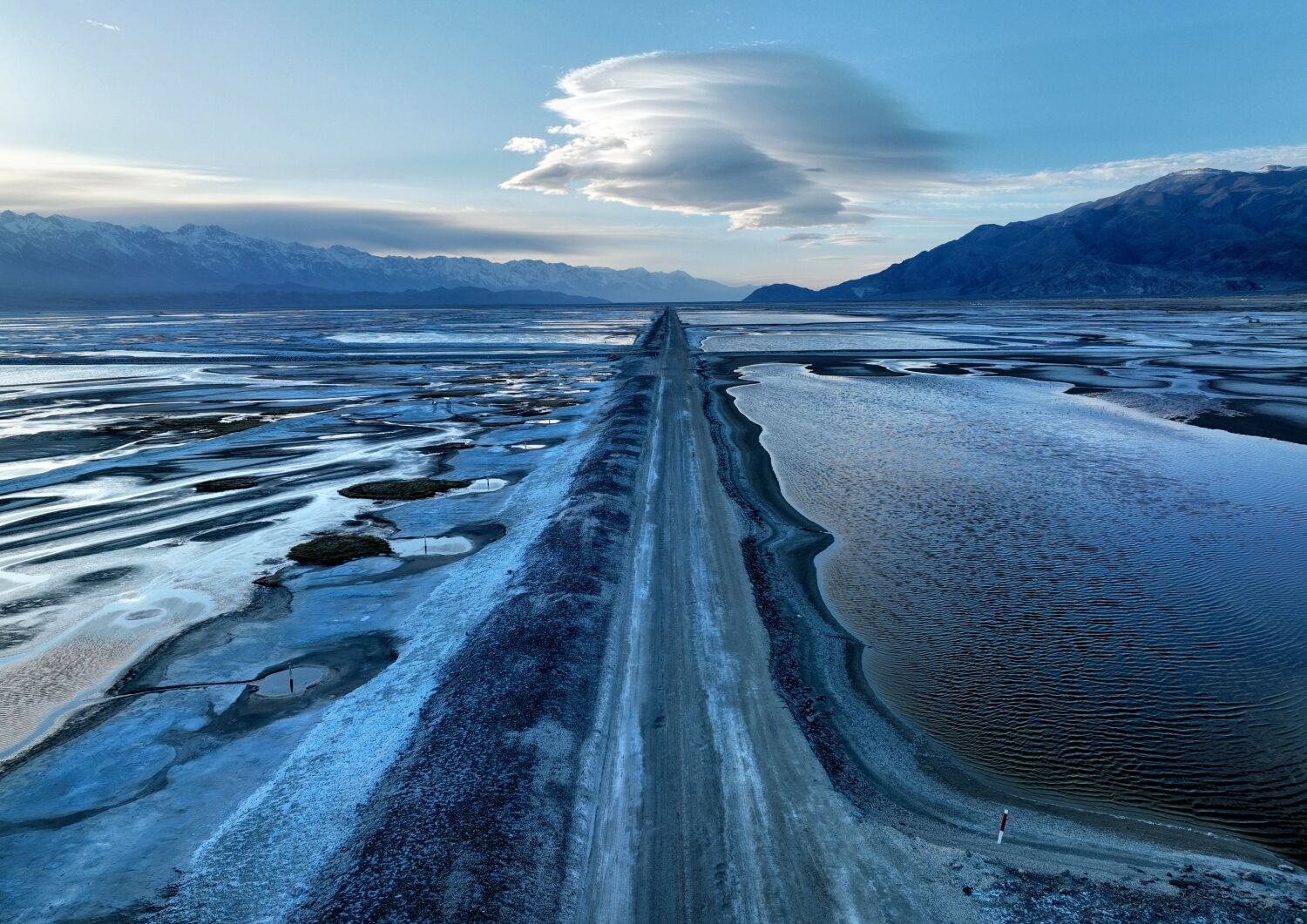Global Courant 2023-04-27 17:00:46
OLANCHA, California —
More than a month after severe storms eroded part of the Los Angeles Aqueduct, work crews are still busy making repairs and strengthening flood defenses in the face of a week-long heat wave that threatens to lead to widespread snowmelt in the Sierra Nevada.
“We’re doing as much as we can, as quickly as possible,” said Paul Liu of the Los Angeles Department of Water and Power. “Our crews work 12-hour shifts.”
Historic snowpack levels in the eastern Sierra are expected to melt in runoff that is 225% of normal, translating to about 326 billion gallons of water to manage, DWP officials said.
And while a typical runoff season in the region may last from May to June, this year “could last until August,” said Anselmo Collins, senior assistant general manager of the DWP’s water system.
Paul Liu, manager of the Owens Lake Dust Mitigation Program, visits the lake, where expected flooding from a snow pack in the Sierra Nevada threatens dust control operations.
(Carolyn Cole/Los Angeles Times)
The DWP has already begun emptying reservoirs to create more storage space for the approximately 130 billion gallons of water expected to arrive via the aqueduct to Los Angeles this spring and summer — potentially enough to meet 80% of LA’s annual demand. comply.
The hope is that most snow on the mountains will remain frozen long enough to give DWP, Inyo County, state and federal disaster officials enough time to prepare for widespread flooding expected when summer temperatures rise.
LA’s water lifeline to the Owens Valley has never had such a long-lasting flood threat. The fragility of the ancient system was brought into sharp focus on March 10, when storm surges destroyed a 120-foot section of the aqueduct near Olancha.
It was the first time in history that extreme weather had breached the 200-mile aqueduct, jeopardizing water supplies to 4 million Los Angeles taxpayers.
To drain, dry and repair the breach, DWP crews first opened the sluice gates of aqueducts 25 miles north.
Those discharges, however, turned the lake’s alkaline bottom into a swirling floodplain of corrosive streams that plagued diversion systems, gnawed through 18 miles of roads and berms and encroached on pumping stations and high-voltage electrical infrastructure that would take millions of dollars and several years to replace, they said. officials.
With forecasters predicting the state’s first heat wave of the season, there’s little time to rest for the crews who use earthmoving equipment, excavators and cranes to reinforce damaged berms with rocks and boulders, and to surround vulnerable roads and critical infrastructure with K-rail barrier walls.
Los Angeles Aqueduct manager Adam Perez describes how a flood breach was repaired in March.
(Gary Coronado/Los Angeles Times)
Adam Perez, manager of the aqueduct, said the DWP “is considering seeking fees from the California Office of Emergency Services to cover the millions of dollars it took to repair the breach in March.”
Among the infrastructure at stake is $2.5 billion in dust control systems that the City of Los Angeles must install to combat hazardous dust pollution — an environmental consequence of LA’s reclamation of Owens Lake more than a century ago.
“Most of the repair work will be completed by June,” said Liu, head of the DWP’s dust control program. “But with all that snow still out there in the mountains, our crews could be here much longer.”
It’s not all bad news. The chatter and roar of heavy machinery hasn’t stopped tens of thousands of waterfowl, gulls and shorebirds from taking advantage of tens of square miles of new, inadvertently created wetlands to rest and gather on brine flies before completing their migrations to breeding grounds as far north like the North Pole.
American avocets, which feed on brine flies, fly past Owens Lake, a Shorebird Reserve Network site of international importance in the Western Hemisphere.
(Carolyn Cole/Los Angeles Times)
But elsewhere in Owens Valley, a canyon of high desert between the Sierra Nevada and the White and Inyo Mountains, DWP officials and property owners see signs of concern lurking in ponds, lakes, creeks, irrigation canals and fields that have already be full of melting snow.
Drought, wildfires, flooding and heavy snowfall are nothing new in the Eastern Sierras. But this year, the region is reflecting patterns of extreme weather worldwide.
The opening of trout season on April 29 at Crowley Lake is typically a spectacle with anglers in boats trolling in all directions.
Water soaks the ground at Lower Owens River.
(Carolyn Cole/Los Angeles Times)
But as of April 21, the lake was still frozen and the only boating concession on the lake announced it was “safe to expect delays of at least a week.”
“This is an unprecedented situation,” said Abby Thomason, owner and general manager of Crowley Lake Fish Camp. “We’ll look at it day by day, when it thaws more we’ll open, but we can’t say when that will be.”
Inyo National Forest officials announced last week that “to protect the public and safety and natural resources,” it was closing several lower-level dirt roads “because of storm damage and the forecast of spring melt runoff that would further them to influence.”
“We know everyone longs to get out and enjoy springtime adventures on the Inyo,” said Scott Kusumoto, acting director of the Inyo National Forest, “and we are committed to making repairs and roads to reopen when conditions permit.”
Water recently surrounds a pumping station on the vast dry bed of Owens Lake.
(Carolyn Cole/Los Angeles Times)
The challenge now is to prevent the abundance of Sierra melting snow that is expected to flow through the aqueduct this spring and summer from flooding and inundating the lake bed, as well as fields, homes and businesses.
DWP activities have raised concerns in Owens Valley since the early 1900s, when Los Angeles agents posed as ranchers and farmers to purchase land and water rights in the area, then began construction of an aqueduct to collecting and diverting the water that had been sustaining Owens Lake. for 800,000 years.
By 1926, the diversions that began in 1913 had dried up most of Owens Lake, causing huge, windblown layers of powder-fine, lung-damaging particles to settle downwind on towns.
Under court orders, the DWP has spent more than $2.5 billion over the past three decades to transform the lake’s stark heritage with dust control projects, including shallow flooding that has reduced emissions of salty, alkaline toxic dust by nearly 100%. .
In what is now hailed as an astonishing accidental ecological success story, brine flies soon reverted to the thin sheen of water that was tinted bright green, red and orange by algae and bacteria. Then came tens of thousands of waterfowl and shorebirds that fed on the brine flies.
American avocets recently feed on brine flies on Owens Lake.
(Carolyn Cole/Los Angeles Times)
In 2018, Owens Lake was designated a Western Hemisphere Shorebird Reserve Network Site of International Importance, joining an exclusive group of 104 areas between Alaska and the southern end of South America that are certified for their outstanding birdlife.
Last week, utility repair work on the lake bed coincided with the eighth annual Owens Lake Bird Festival, which drew more than 100 wildlife enthusiasts from across the country.
The event is co-hosted by many of the conservationists who have been instrumental in holding LA accountable for dust storms that descended on an area of dormant volcanoes, spiky lava fields, craggy mountains, and cascading creeks.
On a recent morning, Owens Valley botanist Mike Prather, who helped organize the bird festival, scanned a flooded northern part of the lake floor with binoculars, smiled, and said, “Wow. It’s a good day for migratory birds.”
“It also looks like the DWP is protecting its investments pretty well,” he added, “as well as the wildlife here.”
American avocets, feeding on brine, fly past Owens Lake, a Western Hemisphere Shorebird Reserve Network site of international importance.
(Carolyn Cole/Los Angeles Times)








